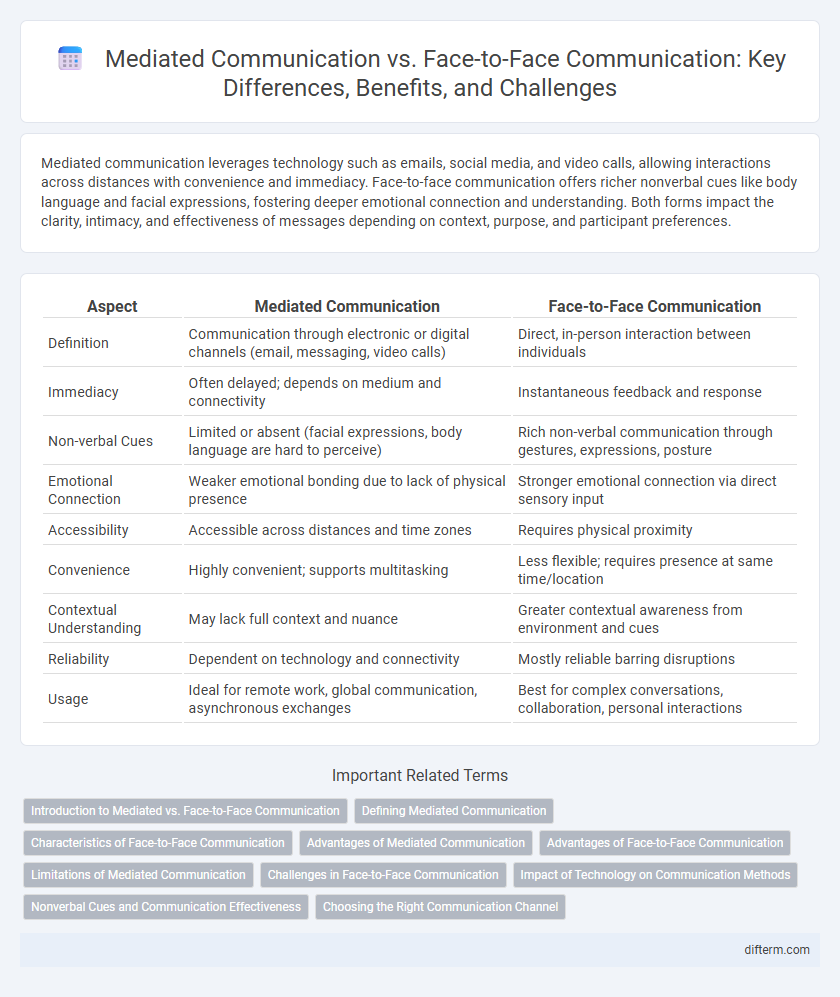Mediated communication leverages technology such as emails, social media, and video calls, allowing interactions across distances with convenience and immediacy. Face-to-face communication offers richer nonverbal cues like body language and facial expressions, fostering deeper emotional connection and understanding. Both forms impact the clarity, intimacy, and effectiveness of messages depending on context, purpose, and participant preferences.
Table of Comparison
| Aspect | Mediated Communication | Face-to-Face Communication |
|---|---|---|
| Definition | Communication through electronic or digital channels (email, messaging, video calls) | Direct, in-person interaction between individuals |
| Immediacy | Often delayed; depends on medium and connectivity | Instantaneous feedback and response |
| Non-verbal Cues | Limited or absent (facial expressions, body language are hard to perceive) | Rich non-verbal communication through gestures, expressions, posture |
| Emotional Connection | Weaker emotional bonding due to lack of physical presence | Stronger emotional connection via direct sensory input |
| Accessibility | Accessible across distances and time zones | Requires physical proximity |
| Convenience | Highly convenient; supports multitasking | Less flexible; requires presence at same time/location |
| Contextual Understanding | May lack full context and nuance | Greater contextual awareness from environment and cues |
| Reliability | Dependent on technology and connectivity | Mostly reliable barring disruptions |
| Usage | Ideal for remote work, global communication, asynchronous exchanges | Best for complex conversations, collaboration, personal interactions |
Introduction to Mediated vs. Face-to-Face Communication
Mediated communication utilizes digital platforms such as emails, video calls, and social media to connect individuals, enabling interaction across geographical distances. Face-to-face communication involves direct, in-person interactions where verbal and nonverbal cues like body language and facial expressions enhance message clarity and emotional understanding. The choice between mediated and face-to-face communication impacts relationship dynamics, immediacy of feedback, and context interpretation in various social and professional settings.
Defining Mediated Communication
Mediated communication refers to the exchange of messages between individuals through a technological medium, such as email, social media, or video conferencing platforms, distinguishing it from face-to-face communication where interactions occur in person without technological intermediation. This form of communication relies on digital tools that transmit, store, and receive information, altering the immediacy and nonverbal cues present in traditional interactions. Understanding mediated communication involves analyzing the impact of various channels on message clarity, emotional expression, and relationship development.
Characteristics of Face-to-Face Communication
Face-to-face communication features rich nonverbal cues such as eye contact, facial expressions, and body language that enhance message clarity and emotional connection. Immediate feedback enables real-time adjustments, reducing misunderstandings and fostering more effective dialogue. This direct interaction creates a stronger sense of trust and personal presence compared to mediated communication channels.
Advantages of Mediated Communication
Mediated communication enables instant connection across vast geographical distances, enhancing accessibility and convenience in personal and professional interactions. It offers diverse modalities such as text, video, and audio, allowing individuals to tailor their communication to specific contexts and preferences. The ability to archive and retrieve messages provides a valuable resource for information sharing and accountability.
Advantages of Face-to-Face Communication
Face-to-face communication enables immediate feedback through nonverbal cues such as facial expressions, gestures, and tone of voice, enhancing understanding and emotional connection. It fosters trust and rapport by creating a personal atmosphere that is difficult to replicate in mediated communication channels like email or video calls. The richness of in-person interactions supports clearer conflict resolution and more effective collaboration in both professional and personal settings.
Limitations of Mediated Communication
Mediated communication often lacks nonverbal cues such as facial expressions, tone of voice, and body language, which are crucial for interpreting emotions and intentions accurately. Technical issues like latency, connectivity problems, and limited sensory input can disrupt the flow and clarity of messages. These limitations can lead to misunderstandings, reduced emotional connection, and diminished trust compared to face-to-face communication.
Challenges in Face-to-Face Communication
Face-to-face communication often encounters challenges such as misinterpretation due to nonverbal cues, emotional intensity affecting clarity, and environmental distractions that disrupt message delivery. Unlike mediated communication, which allows time for message processing and editing, real-time interactions demand immediate responses, increasing the likelihood of misunderstandings. Furthermore, physical presence can sometimes lead to social pressure or anxiety, hindering open and effective communication.
Impact of Technology on Communication Methods
The impact of technology on communication methods has transformed mediated communication by enabling instant connectivity through digital platforms such as video calls, social media, and messaging apps. These technological advancements enhance accessibility and convenience but may reduce nonverbal cues and emotional richness found in face-to-face communication. Despite these limitations, mediated communication facilitates global interactions and collaboration beyond geographical boundaries, reshaping modern interpersonal and professional communication dynamics.
Nonverbal Cues and Communication Effectiveness
Nonverbal cues such as facial expressions, gestures, and eye contact play a crucial role in face-to-face communication by enhancing message clarity and emotional understanding. Mediated communication often lacks these visual signals, leading to potential misunderstandings and reduced communication effectiveness. The absence of nonverbal feedback in digital interactions can hinder relationship building and the accurate interpretation of intent.
Choosing the Right Communication Channel
Selecting the appropriate communication channel depends on the message complexity, urgency, and the need for nonverbal cues. Face-to-face communication excels in conveying emotions and building trust through body language and tone, making it ideal for sensitive or nuanced discussions. Mediated communication offers convenience and reach but may lack immediacy and subtlety, requiring careful consideration to avoid misunderstandings.
mediated communication vs face-to-face communication Infographic

 difterm.com
difterm.com